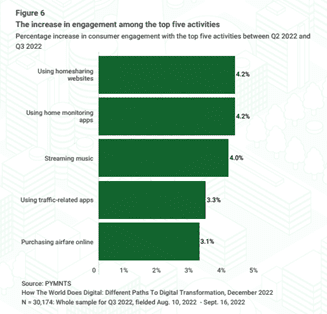Marking the forward march of connected devices and ecosystems against forceful macroeconomic headwinds, the PYMNTS study How The World Does Digital: Different Paths To Digital Transformation analyzed roughly three million data points from 11 national economies and found that the great digital shift was slowed but not stopped, by current market conditions.
“Digital transformation crept forward again in Q3 2022, with the ConnectedEconomy™ Index climbing to 27.6 from 27.4 in Q2 — a 0.7% increase,” the study says, while noting the continued rise in digital activities across the economies studied, both in terms of the number of consumers engaging in digital activities and the frequency with which they do so.
However, the report also pointed out the latest reading was also down from the 1.2% increase observed in Q2, which was largely driven by an uptick in travel and related digital activities. In contrast, increases in digital activity frequency played a more significant part in Q3.
In short, more consumers conducted daily digital activities in Q3 than in Q2, reflecting an increased preference to carry out routine tasks digitally.
Get the Report: How The World Does Digital: Different Paths To Digital Transformation
Advertisement: Scroll to Continue

The digital activities that kept the pace of digital transformation moving forward still showed healthy travel-related connected economy usage. Still, other activities, including streaming entertainment, navigation and smart home monitoring contributed to the slight increase.
“Consumers upped their use of home monitoring systems by 4.2%, with 3.4% more using these tools daily. Their use of home-sharing websites also rose by 4.2%. The other areas with the most notable engagement growth include music streaming, up 4%, traffic-related apps, up 3.3%, and online airfare, up 3.1%,” the study states.
See more: How The World Does Digital: Different Paths To Digital Transformation